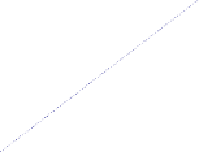Environmental Engineering Reference
In-Depth Information
results in Figures 5.26 and 5.27. The applied uniform increase of demand, by changing the
demand multiplier alone, creates uniform consequences after the pipe failures. Thus, the
ranking of pipes based on their criticality will remain the same except that the demand loss
will grow. The visual representation of this phenomenon is that the dots on the HRD start to
migrate towards the diagonal of the graph in uniform pattern, as shown in Figure 5.27. With
further demand increase, they will gradually enter the area underneath the diagonal indicating
the condition in which the pressure in the network is below the PDD threshold i.e. the
demand reduction takes place even at no-pipe failure condition. The dots on the other side of
the diagonal introduce negative values in the calculation of NBI, which starts affecting, i.e.
reducing the index more significantly. This however has no big impact on the reduction of
ADF values for the network as the dots located below the diagonal represent in this particular
case the pipes conveying marginal flows and therefore inflicting marginal loss of demand, if
any, in case of their failure. Moreover, these pipes influence the value of
ADF
avg
in negative
way, showing the network more reliable than it really is.
1.00
Underconnected
0.90
0.80
0.70
0.60
Q +32%
Q +73%
Q +98%
Branched
0.50
0.40
0.30
0.20
0.10
Overconnected
0.00
0.00
0.20
0.40
0.60
0.80
1.00
1-ADF
Figure 5.26
HRD of Amsterdam North for increased level of demand
0.05
Q +32%
Q +73%
Q +98%
Branched
0.00
0.00
0.05
1-ADF
Figure 5.27
Zoom-in of Figure 5.26



























































































































































































































































































































































































































































































































































































































































































































































































































































































































































































































































































































































































































































































































































































































































































































































































































































































































































































































































































































































































































































































































































































































































































































































































































































































































































































































































































































































































































































































































































































































































































































































































































































































































































































































































































































































































































































































































































































































































































































































































































































































































































































































































































































































































































































































































































































































































































































































































































































































































































































































































































































































































































































































































































































































































































































































































































































































































































































































































































































































































































































































































































































































































































































































































































































































































Search WWH ::

Custom Search